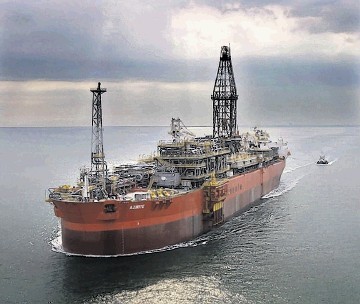
Petrobras continues to drive the floating production market by signing for the conversion of four further VLCCs (very large crude carriers) into new production, storage, and offloading vessels (FPSOs) at a cost of $1.7billion.
The latest conversions will be for the hulls of the future P-74, P-75, P-76, and P-77 FPSOs that will operate in the Transfer of Rights Agreement areas, in the Santos Basin pre-salt sector.
The work will be done at the Inhauma Shipyard in Rio de Janeiro state, which was leased by Petrobras and is being refurbished to meet the company’s needs.
Conversion operations are scheduled to start in June. The first unit in the series is the P-74, with conversion expected to be completed in March 2014. Conversion of the P-75 hull is expected to be completed in October 2014, while the hulls for the P-76 and P-77 are scheduled for 2015.
Each hull will be taken to another facility for the installation of the production plant and the oil and gas processing modules. This work should be contracted by April 2013.
This batch exemplifies the current boom in floating production systems.
According to US analysts IMA, the current global population of floating production systems now stands at 257 units.
This figure is 30% greater than five years ago and 90% higher than ten years back.
FPSOs – converted tankers and purpose-built – account for 62% of the existing systems. The balance comprises production semi-submersibles, tension leg platforms, production spars, production barges and floating regasification/storage units (FSRUs).
Seven units (all FPSOs) are off-field and available for reuse – resulting in an overall utilisation rate of 97.3%. Another 100 floating storage/offloading units (without production capability) are in service.
Order backlog will increase the production floater inventory by 25%, says IMA.
The current order backlog consists of 67 production floaters – 45 FPSOs, five production semis, three TLPs, three spars, two floating LNG producers and nine FSRUs.
Within this backlog, 36 units will be based on purpose-built hulls and 31 units based on converted tanker hulls.
Of the production floaters being built, 37 are owned by field operators while 30 are being supplied by leasing contractors.
Brazil continues to dominate orders for production floaters. Of the 67 units on order, 28 are being built for use offshore Brazil, which accounts for 42% of the order backlog.
The number of planned floaters has been growing – 216 projects potentially requiring a floating production or storage system are now in the planning stage, says IMA.
A year ago, 194 projects were being planned. Five years ago, the figure was 109 projects.
Jim McCaul, head of IMA, said: “The growth in number of planned projects reflects the solid fundamentals underlying the floating production sector.
“The 150 drill-ships and deepwater drill semis ordered since 2005 have removed a bottleneck constraining exploration in deepwater, resulting in
a dramatic increase in floater projects in the planning pipeline.”
Orders for 130 to 190 production floaters are forecast over the next five years – FPSOs are expected to account for around 75% of future production floater orders.
The remaining 25% will be production semis, spars, TLPs, FLNGs and FSRUs.
Orders for 25 to 35 FSOs are also expected over the next five years.
Around 60% of orders will be placed by leasing contractors, 40% by field operators. Modification and redeployment of existing FPSOs will satisfy around 20% of future FPSO requirements.”
Other than those built/converted by Petrobras in Brazil and spar units fabricated in Europe, by far the majority of future floating production units will be built by yards in the Far East, even though a significant number will be built to European account. This will therefore continue the trend of denying European yards billions of dollars worth of business opportunities.